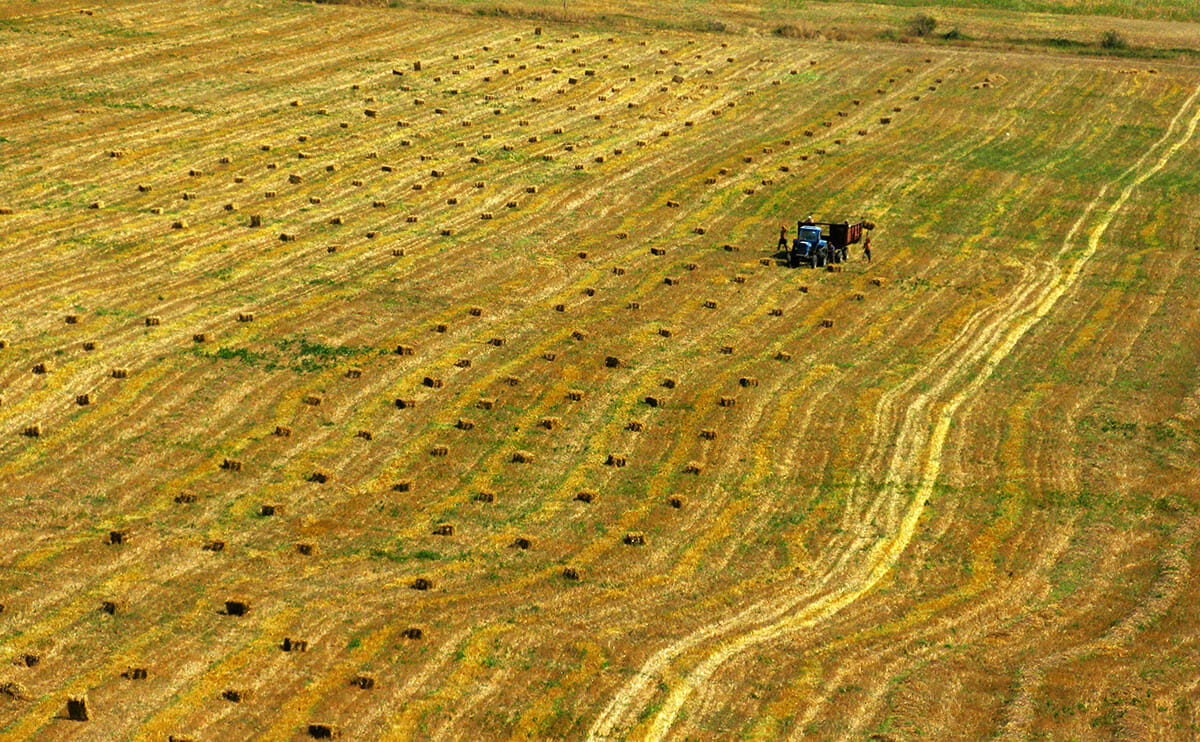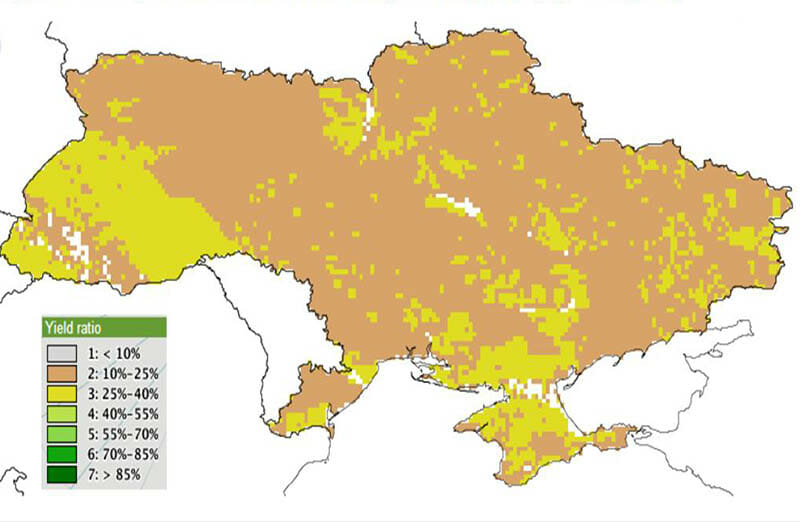Turmoil in Ukraine Presses Uncertainty on Farmers and Investors
Farmers and investors wait to see how the ultra-fertile fields of the Ukraine will ride out the ongoing political crisis.
Turmoil in Ukraine Presses Uncertainty on Farmers and Investors
Farmers and investors wait to see how the ultra-fertile fields of the Ukraine will ride out the ongoing political crisis.

While that might sound like speculative fiction, the question has pressed the futures markets for grains to extremes in the last few days.
On Monday, Putin’s invasion of the Crimean Peninsula pushed futures for wheat for delivery in May up 5.9 percent to $6.38 a bushel on the Chicago Board of Trade, marking the largest single-day surge in almost 18 months. Corn futures rose 3.7 percent to a six-month high of $4.81. Both markets declined Tuesday morning when Putin announced that his armies would stay put.
‘The amount of money that could come into Ukraine hasn’t come yet, and if it does we should see a huge jump in yields. This revolution could be the catalyst.’
Mike Lee, the managing director of a private agricultural investment in Ukraine and writer of AgronomyUkraine, has felt an according level of uncertainty as the political drama has played out. Two weeks ago, as he watched protests in Kiev turn violent, he considered packing up his family and driving across the Polish border. Now, he is cautiously optimistic about the new, western leaning government.
“The amount of money that could come into Ukraine hasn’t come yet, and if it does we should see a huge jump in yields,” he said over Skype on Tuesday. “This revolution could be the catalyst.”
A quick look at a map demonstrates why Lee’s investors, along with many others, are so bullish on Ukraine. The country has hungry markets on all sides with Europe to the west, Russia to the east and much of the Middle East accessible over the Black Sea.
On the production side, Ukraine — already forecast to be the third-largest wheat exporter and the sixth-largest corn shipper this season — has plenty of room to grow. A report commissioned by the European Union in 2013 estimates that there is a 10 to 40 percent gap between Ukraine’s actual and potential yields.
Much of the optimism grows from the country’s soil. Ukraine claims 25 percent of the world’s “black soil,” which is so fertile that illegal truckloads of the stuff amounted to $900 million in sales in 2011.

So why haven’t investors already bolted across the borders with money for Ukrainian farmers? Lee says Ukraine’s complex system of citizen land ownership makes farming a bureaucratic nightmare for individual investors, who often have to employ teams to do the paperwork.
China, however, has been more than willing to face the challenge. Last fall, Ukraine agreed to let China rent 5 percent of its land — an area roughly the size of Massachusetts — to grow crops and raise livestock over the next 50 years.
For now, worries over Ukraine’s agricultural sector appear to have calmed. Ihor Shvaika, Ukraine’s newly appointed minister of agriculture, told Reuters Monday he would work to make sure that farmers would plant their spring crops per usual. And while Lee anticipates this will be far from the easiest season for farmers to secure seeds and inputs, he expects they will get it done — that is, as long as nothing else changes.
“At the moment, the truth is we don’t know what’s going to happen,” says Lee. “In 12 days we’ve lost the government and there’s been an invasion.”
But he’s hoping the political revolution goes hand-in-hand with an agrarian one.
Follow us
This work is licensed under a Creative Commons Attribution-NoDerivatives 4.0 International License.
Want to republish a Modern Farmer story?
We are happy for Modern Farmer stories to be shared, and encourage you to republish our articles for your audience. When doing so, we ask that you follow these guidelines:
Please credit us and our writers
For the author byline, please use “Author Name, Modern Farmer.” At the top of our stories, if on the web, please include this text and link: “This story was originally published by Modern Farmer.”
Please make sure to include a link back to either our home page or the article URL.
At the bottom of the story, please include the following text:
“Modern Farmer is a nonprofit initiative dedicated to raising awareness and catalyzing action at the intersection of food, agriculture, and society. Read more at <link>Modern Farmer</link>.”
Use our widget
We’d like to be able to track our stories, so we ask that if you republish our content, you do so using our widget (located on the left hand side of the article). The HTML code has a built-in tracker that tells us the data and domain where the story was published, as well as view counts.
Check the image requirements
It’s your responsibility to confirm you're licensed to republish images in our articles. Some images, such as those from commercial providers, don't allow their images to be republished without permission or payment. Copyright terms are generally listed in the image caption and attribution. You are welcome to omit our images or substitute with your own. Charts and interactive graphics follow the same rules.
Don’t change too much. Or, ask us first.
Articles must be republished in their entirety. It’s okay to change references to time (“today” to “yesterday”) or location (“Iowa City, IA” to “here”). But please keep everything else the same.
If you feel strongly that a more material edit needs to be made, get in touch with us at [email protected]. We’re happy to discuss it with the original author, but we must have prior approval for changes before publication.
Special cases
Extracts. You may run the first few lines or paragraphs of the article and then say: “Read the full article at Modern Farmer” with a link back to the original article.
Quotes. You may quote authors provided you include a link back to the article URL.
Translations. These require writer approval. To inquire about translation of a Modern Farmer article, contact us at [email protected]
Signed consent / copyright release forms. These are not required, provided you are following these guidelines.
Print. Articles can be republished in print under these same rules, with the exception that you do not need to include the links.
Tag us
When sharing the story on social media, please tag us using the following: - Twitter (@ModFarm) - Facebook (@ModernFarmerMedia) - Instagram (@modfarm)
Use our content respectfully
Modern Farmer is a nonprofit and as such we share our content for free and in good faith in order to reach new audiences. Respectfully,
No selling ads against our stories. It’s okay to put our stories on pages with ads.
Don’t republish our material wholesale, or automatically; you need to select stories to be republished individually.
You have no rights to sell, license, syndicate, or otherwise represent yourself as the authorized owner of our material to any third parties. This means that you cannot actively publish or submit our work for syndication to third party platforms or apps like Apple News or Google News. We understand that publishers cannot fully control when certain third parties automatically summarize or crawl content from publishers’ own sites.
Keep in touch
We want to hear from you if you love Modern Farmer content, have a collaboration idea, or anything else to share. As a nonprofit outlet, we work in service of our community and are always open to comments, feedback, and ideas. Contact us at [email protected].by Sam Brasch, Modern Farmer
March 5, 2014
Modern Farmer Weekly
Solutions Hub
Innovations, ideas and inspiration. Actionable solutions for a resilient food system.
ExploreExplore other topics
Share With Us
We want to hear from Modern Farmer readers who have thoughtful commentary, actionable solutions, or helpful ideas to share.
SubmitNecessary cookies are absolutely essential for the website to function properly. This category only includes cookies that ensures basic functionalities and security features of the website. These cookies do not store any personal information.
Any cookies that may not be particularly necessary for the website to function and are used specifically to collect user personal data via analytics, ads, other embedded contents are termed as non-necessary cookies.